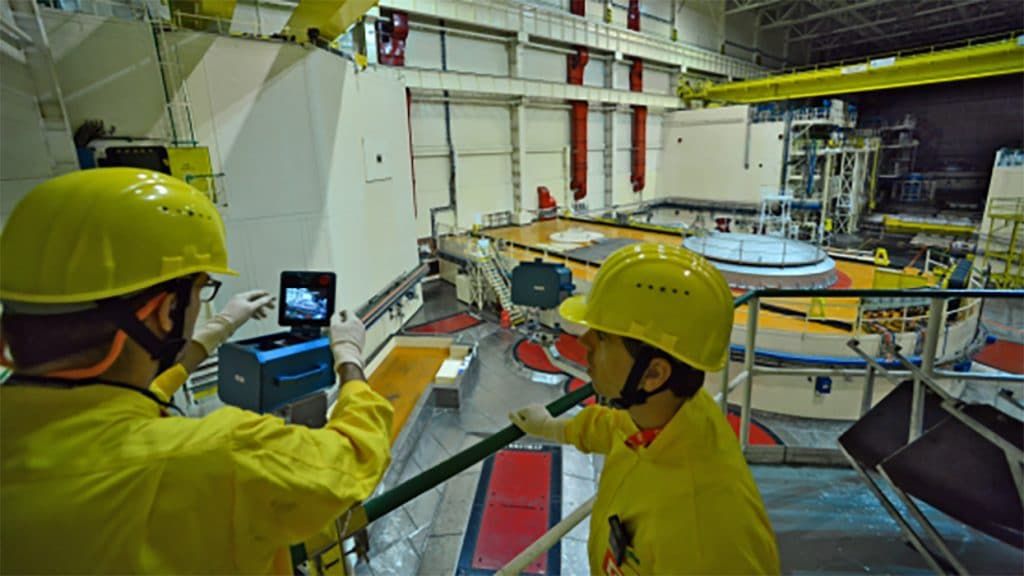Round-the-clock surveillance of Iran’s uranium-enrichment sites continues, despite coronavirus
By Tariq Rauf | March 25, 2020
 Safeguards inspectors setting up a camera for round-the-clock surveillance of operations at the Dukovany Nuclear Power Plant in the Czech Republic. Image courtesy of D. Calma/IAEA.
Safeguards inspectors setting up a camera for round-the-clock surveillance of operations at the Dukovany Nuclear Power Plant in the Czech Republic. Image courtesy of D. Calma/IAEA.
While George Moore is well-intentioned in his recent Bulletin article on the challenges of continuing on-site International Atomic Energy Agency (IAEA) safeguards in Iran at a time when the coronavirus is spreading rapidly in that country (see “One potential victim of coronavirus? Nuclear inspections in Iran”), it is important not to exaggerate the situation or raise false alarms. I base this statement upon my own experiences, as the former Head of Verification and Security Policy at the IAEA in Vienna, where I dealt with high-priority verification cases involving Iran, Iraq, Libya, North Korea, South Korea, and Syria.
This is not the first time that the IAEA’s staff has faced novel, hazardous operating conditions. Agency staff continued to bravely perform their vital missions during the Chernobyl and Fukushima nuclear accidents, working in highly radioactively contaminated environments. Both before and after the invasion of Iraq in 2003, IAEA inspectors continued their vital mission of nuclear verification there, under highly dangerous conditions. They also have conducted their safeguards missions in other conflict-ridden regions of the world without hesitation. IAEA staff has never been deterred to carry out their responsibilities for nuclear safeguards, safety, and security, even under extremely adverse conditions.
All IAEA operations are continuing during the outbreak of the coronavirus—also known as COVID-19—as the organization stated in its latest official notification. Indeed, safeguards inspections worldwide are continuing, if with some travel disruptions. And it is important to realize that while in-person, on-site agency inspections may suffer some possible disruption, the IAEA also relies heavily on a variety of installed on-site verification technologies that allow it to monitor nuclear activities remotely.
In recent years, the agency has increased its reliance on unattended containment, surveillance, and monitoring systems installed in sensitive nuclear facilities across the world—including in Iran. According to the organization’s latest “Safeguards Implementation Report,” which contains data for 2018 (the report for 2019 will be released in June this year), the agency had 1,563 cameras connected to 940 systems operating or ready to use at 277 facilities, including Iran—of which 881 were next generation surveillance systems (NGSS) installed in 29 states.
Next generation surveillance systems include specialized cameras manufactured by the IAEA that are housed in tamper-resistant containers and equipped with a long life power supply that can reliably operate for extended periods without access to external power. To ensure the authenticity and confidentiality of surveillance data acquired by the NGSS, three different layers of cryptographic data protection and multiple layers of physical, passive and active tamper-indication technology are used.
For example, a NGSS camera contains a secure surveillance core element to protect the critical electronic components and the optical sensor—as well as the cryptographic data—by an active tamper-indication mechanism. Because surveillance cameras can see movement but cannot detect radiation levels, the agency deploys unattended non-destructive assay monitoring systems that include radiation detectors to measure neutron and gamma radiation, and additional sensors to monitor temperature, flow, and other parameters. These are installed at specific locations at a nuclear facility to characterize and verify nuclear material, monitor the movement of spent fuel, and collect and transmit encrypted data around the clock
There are 171 unattended monitoring systems installed in 24 states. Remote data transmissions not only provide data directly to agency headquarters in Vienna; they enable greater efficiency by relieving inspectors from the task of data collection at facilities as well as early detection of any deterioration in system performance. The data collected from radiation monitoring systems is often analyzed in conjunction with video surveillance to track the movement of nuclear material in the facility: static photos and video streams enable remote observation and assessment by inspectors.
The agency had 1,102 of these unattended data streams transmitting information from 137 facilities in 29 states, including Iran. The costs for implementing nuclear verification or safeguards in Iran in 2018 were relatively modest, considering what is at stake: $17,048,000.
And that’s not all. Prior to the implementation of the Iran agreement (formally known as the Joint Comprehensive Plan of Action, or JCPOA) on January 16 of 2016, the IAEA had installed what is known as an Online Enrichment Monitor or OLEM, a new high-tech device that monitors Iran’s uranium enrichment activities at the Natanz Fuel Enrichment Plant 24 hours per day, seven days a week. It measures the characteristics of gaseous uranium flowing through the processing pipes out of the cascades of centrifuges of the enrichment plant. In each unit of the equipment, the main connection node—a gamma ray detector based on a sodium iodide crystal—measures the amount of uranium 235 in the pipe, while pressure and temperature sensors enable the machine to determine the total quantity of gaseous uranium. From the two, the device can calculate the enrichment level, which can be checked by inspectors on the site. The device can be installed in a configuration to monitor the enrichment levels of the material coming in and out of the gas enrichment centrifuges cascades. Because the device is non-intrusive and does not use a radioactive source, it is safe to maintain and can work autonomously.
The device is tamper-indicating, and connected to a computer contained in a central cabinet on-site, which is also tamper indicating and under the IAEA’s seal. The computer performs calculations, stores results, and transmits encrypted data. The OLEM system includes multiple redundancy components and can operate on battery power, further ensuring its autonomy and reliability. All its components are contained in sealed boxes that are connected by special tubing and all enclosures are under IAEA seal. A special paint is used to ensure that any attempt to tamper with the system will be detected.
The use of OLEM technology at Iran’s enrichment facility serves as a test bed for deployment in other enriching countries, since the technology provides continuous measurement. It has the added benefit of reducing— but not eliminating—the need for sample-taking and environmental sample-taking, resulting in gains in efficiency, and savings in cost for the IAEA.
So far, “Iran has continued to permit the Agency to use on-line enrichment monitors and electronic seals which communicate their status within nuclear sites to Agency inspectors and to facilitate the automated collection of Agency measurement recordings registered by installed measurement devices,” the IAEA’s latest report says. It is vital that Iran continues to facilitate the uninterrupted operation of IAEA unattended monitoring systems installed at the Natanz and Fordow enrichment plants and at other locations in the country.
But beyond these technological innovations, it is important to put the situation in Iran into perspective. As Mark Fitzpatrick noted in an insightful article for the International Institute for Strategic Studies: “Some analysts claim that Iran’s current capabilities have shortened its breakout time to four months or even to three-and-a-half months. Such assessments are based on unrealistic assumptions, including that a country that has never produced weapons-grade uranium could do so without a hitch on the first attempt. And how could Iran’s breakout capability today be close to what it was in 2015, when it had seven times more enriched uranium and twice as many operating centrifuges? It is more reasonable to believe the government experts from key countries who say that in a worst-case scenario, Iran may be six months away from being able to produce enough highly enriched uranium to build a nuclear weapon. These experts are from countries that have produced such weapons, so they speak from the basis of experience.”
This is not to say that one should be complacent about Iran’s increasing enrichment capacity. Rather, we should keep things in perspective and find ways to encourage restraint by Iran and its full cooperation with the IAEA, as well as preserving the JCPOA under which the agency continues to provide detailed information on Iran’s nuclear activities.
Despite the COVID-19 outbreak in Iran, IAEA safeguards activities continue under appropriate protocols to ensure the safety and security of agency personnel, and every effort should be made by the agency and states to ensure continuing application of safeguards, in all countries, in accordance with their respective legal obligations.
One last thought: Considering the present circumstances, sanctions on Iran should be eased for humanitarian and medical reasons, so that it may better combat COVID-19 and prevent its further spread to neighboring countries in the region of the Persian Gulf. We should allow Iran to import necessary medical equipment such as masks, gloves, goggles, ventilators, antibiotics, and other related items as reportedly proposed by both China and the United Kingdom.
And at the same time, as requested by the IAEA director general, it is incumbent upon Iran to provide prompt full access and cooperation to the agency so that it can fully implement the requirements of Iran’s NPT safeguards agreement and of the JCPOA. The agency has identified a number of questions related to possible previous undeclared nuclear material and nuclear-related activities at three locations that have not been declared by Iran. In this regard, Iran should provide immediate access as soon as feasible to the three locations specified by the agency, so as to clarify and resolve outstanding questions. This would enable credible assurance by the IAEA of the absence of undeclared nuclear material and activities in Iran.
Together, we make the world safer.
The Bulletin elevates expert voices above the noise. But as an independent nonprofit organization, our operations depend on the support of readers like you. Help us continue to deliver quality journalism that holds leaders accountable. Your support of our work at any level is important. In return, we promise our coverage will be understandable, influential, vigilant, solution-oriented, and fair-minded. Together we can make a difference.
Keywords: COVID-19, Coronavirus, IAEA, Iran, Iran agreement, JCPOA, nuclear safeguards, uranium enrichment, verification
Topics: Nuclear Weapons, Special Topics















We do need to assure that inspectors can get on site in Natanz, despite the COVID-19 outbreak, because the OLEMs only communicate on site.
In Iran, the Agency serviced all the installed NGSS in February-March and increased their in-built storage capacity by 500%; thus giving the IAEA the capability to keep nuclear material and the facilities under containment and surveillance for up to four months without the need for on-site inspections if these could not be carried out due to international travel restrictions due to COVID-19.
I am grateful that George Moore initiated this discussion and now more information is available as provided by the IAEA and in my response to George. Today, 30 March 2020, the IAEA released the following statement to Member States from the Deputy Director General for Safeguards: Dear Member State colleagues, I want to provide you with an update on the current situation regarding the implementation of IAEA safeguards around the world. Despite the difficult situation at present, the Agency continues to implement safeguards effectively, including through in-field verification. As the Director General said in a recent video message – Agency… Read more »